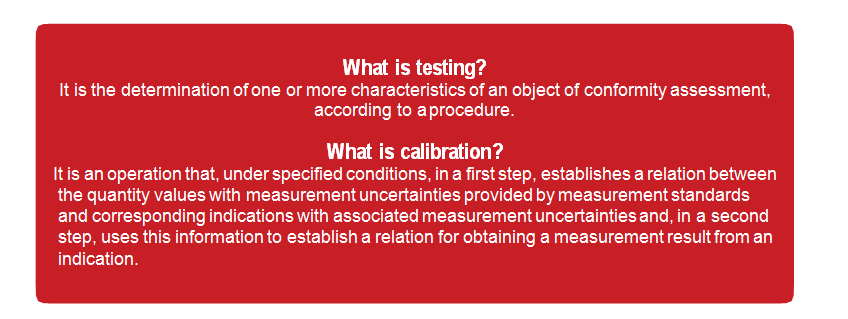The transitioning process from ISO/IEC 27001:2013 to ISO/IEC 2....
ISO 17025 - General Requirements for the Competence of Testing and Calibrating Laboratories

Introduction
Laboratories have to continuously provide high-quality services if they tend to be successful in the marketplace. Using the ISO 17025 standard will assure quality improvement and consistency in an organization.
ISO 17025 is the only internationally accepted standard for laboratory quality systems that provides a globally accepted basis for accreditation. The first version (ISO Guide 25) of this standard was published in 1999, by the International Organization for Standardization (ISO).The second version was released in 2005, which is more aligned with the ISO 9001:2000 standard regarding quality system words.
ISO 17025:2005 specifies the general requirements a laboratory has to meet if it is to be recognized as competent to carry out tests and/or calibrations, including sampling. It covers testing and calibration performed using standardized methods, methods not covered by standardized methods, and laboratory- developed methods.
However, compliance with regulatory and safety requirements on the operation of laboratories are not covered by ISO 17025:2005.
If a laboratory wishes accreditation for part or all of its testing and calibration activities, it should select an accreditation body that operates in accordance with ISO/IEC 17011 (General requirements for accreditation bodies accrediting conformity assessment bodies)
An overview of ISO 17025
ISO/IEC 17025 is the global quality standard for testing and calibration laboratories. It is the basis for accreditation from an accreditation body.
This International Standard is applicable to all organizations performing tests and/or calibrations regardless of the number of personnel or the extent of the scope of testing and/or calibration activities. These include first-, second- and third-party laboratories, and laboratories where testing and/or calibration forms part of inspection and product certification.
There are two main clauses in ISO/IEC 17025:
-
Management requirements – which relate to the operation and effectiveness of the quality management system within the laboratory.
-
Technical requirements - which address the competence of staff; testing methodology; equipment and quality; and reporting of test and calibration results.
What is a Laboratory?
A laboratory is an organization that performs tests and/or calibrations in a permanent, temporary, or remote location.
ISO 17025 applies to organizations performing tests and/or calibrations that wish to:
- Establish, implement and maintain laboratory management system;
- Assure conformity with the laboratories stated quality policy;
- Demonstrate conformity to others;
- Seek accreditation of its laboratory by an accreditation body; and
- Make a self-determination and self-declaration of conformity with this International Standard.
This international standard is for use by laboratories in developing their management system for quality, administrative and technical operations. It can also be used by laboratory customers, regulatory authorities and accreditation bodies to confirm or recognize the competence of laboratories.

Key clauses of ISO 17025:2005
ISO 17025 is organized into the following main clauses:
Clause 4: Management Requirements
Clause 5: Technical Requirements
Each of these key activities is overviewed below
Clause 4: Management requirements
Management requirements relate to the operation and effectiveness of the quality management system within the laboratory.
Organization –The roles and responsibilities of the laboratory, the management and key personnel are defined.
Management system – The laboratory management system shall be properly implemented, maintained and improved based on the ISO 17025 requirements.
Document control – All documents that are part of the management system are identified, created, approved, issued and changed according to procedures.
Review of requests, tenders and contracts – The requirements for requests, tenders and contracts are defined, documented and understood.
Subcontracting of tests and calibrations – This sub-clause describe how to ensure that subcontracting tests and/or calibrations are performed by competent subcontractors.
Purchasing services and supplies – Management shall ensure that purchased services and supplies do not affect the quality of test and/or calibrations.
Service to the customers – The laboratory shall continually meet customer requirements. Complaints – All complaints received are documented, evaluated and followed up.
Control of nonconforming testing and/or calibration work – Nonconforming test and calibration results are followed up and corrected.
Improvement – The effectiveness of the laboratory management system is continually improved.
Corrective action – The root cause of nonconformities are identified and adequate corrective actions are selected, implemented, documented and monitored.
Preventive action – Preventive actions shall be initiated when potential sources of nonconformities have been identified.
Controls of records – Records are identified, available when needed, and protected against unauthorized access.
Internal audits – The laboratory shall conduct internal audits periodically to verify compliance with the requirements of the management system and ISO 17025.
Management review – Management reviews shall be conducted to ensure suitability and effectiveness of the management system and testing and/or calibration activities.
Clause 5: Technical Requirements
Technical requirements relate to the competence of staff, sampling and testing methodology, equipment and the quality and reporting of test and calibration results.
Personnel – All laboratory personnel that have the highest impact on test and calibration results are adequately competent.
Accommodation and environmental conditions – The laboratory shall ensure that the facilities for testing and/or calibration do not invalidate results or adversely affect the quality.
Test and calibration methods and method validation – Appropriate methods for test and/or calibrations shall be used to ensure accuracy in results.
Equipment – The laboratory shall use appropriate and properly maintained equipment for the correct performance of tests and/or calibrations.
Measurement traceability – All measurements shall be traceable to the International System of Units (SI).
Sampling – The laboratory shall implement sampling procedures to ensure that statistically relevant representative samples are taken and documented.
Handling of test and calibration items – The laboratory shall protect the integrity of test and/or calibration items during transportation, receipt, handling, storage, retention and/or disposal.
Assuring the quality of test and calibration results – The laboratory shall continually ensure the quality of results.
Reporting of results – Obtained results shall be properly reported by ensuring clarity and accuracy.
ISO 17025 opposed to ISO 9001
Both standards have similar requirements included in their management systems.ISO 9001 is a standard that specifies requirements for a quality management system. It applies to companies designing, manufacturing, servicing, calibrating and testing.
Meanwhile, besides the fact that ISO 17025 provides the requirements for a management system, it also delivers technical requirements for laboratories performing testing and/or calibration services.
The business benefits of a laboratory management system
As with all major undertakings within an organization, it is essential to gain the backing and sponsorship of executive management. By far the best way to achieve this, rather than through highlighting the negative aspects of not having a laboratory management system is to illustrate the positive gains of having an effective quality management process in place.
The adoption of an effective laboratory management process within an organization will have many benefits in a number of areas:
Increase of confidence in testing and/or calibration results;
Better control of laboratory operations;
Improved reputation and image of the laboratory;
National and international recognition;
Continually improvement of quality and laboratory effectiveness; and
Recognition of testing competence.
Why is PECB a worthy choice?
Implementation of LMS with IMS2 methodology
Considering the well documented benefits of implementing a Laboratory Management System based on ISO17025, makes the proposal easier to decide on.
Most organizations now realize that it is not sufficient to implement a generic, “one size fits all” laboratory management plan. For an effective response, with respect to maintaining the laboratory management system, such a plan must be customized to fit to an organization. A more difficult task is the compilation of an implementation plan that balances the requirements of the standard, the business needs and the certification deadline.
There is no single blueprint for implementing ISO 17025 that will work for every organization, but there are some common steps that will allow you to balance the frequent conflicting requirements and prepare you for a successful certification audit.
PECB has developed a methodology (please see example below) for implementing a management system; the “Integrated Implementation Methodology for Management Systems and Standards (IMS2)”, and it is based on applicable best practices. This methodology is based on the guidelines of ISO standards and also meets the requirements of ISO 17025.

MS2 is based on the PDCA cycle divided into four phases: Plan, Do, Check and Act. Each phase has between 2 and 8 steps for a total of 18 steps. In turn, these steps are divided into 101 activities and tasks. This Practical Guide’ considers the key phases in your implementation project from start to finish and suggests the appropriate ‘best practice’ for each one, while directing your to further helpful resources as you embark on your ISO 17025 journey.

The sequence of steps can be changed (inversion, merge). For example, the implementation of the management procedure for documented information can be done before the understanding of the organization. Many processes are iterative because of the need for progressive development throughout the implementation project; for example, communication and training.
By following a structured and effective methodology, an organization can be sure it covers all minimum requirements for the implementation of a management system. Whatever methodology used, the organization must adapt it to its particular context (requirements, size of the organization, scope, objectives, etc...) and not apply it like a cookbook.
Principal Authors:
Eric LACHAPELLE, PECB
Besnik HUNDOZI, PECB



